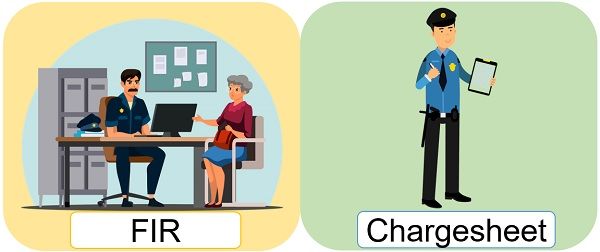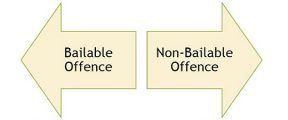 FIR, or First Information Report, is the written document that police prepare upon receiving information regarding the occurrence of a cognizable offence. It is an important document both from the point of view of prosecution and defence. It acts as the foundation of the case, as the entire case depends on it. The police initiate the crime investigation only after the registration of the FIR.
FIR, or First Information Report, is the written document that police prepare upon receiving information regarding the occurrence of a cognizable offence. It is an important document both from the point of view of prosecution and defence. It acts as the foundation of the case, as the entire case depends on it. The police initiate the crime investigation only after the registration of the FIR.
On the other hand, the chargesheet is a final formal document of accusation that the police prepares. It contains the opinion of the investigating officer that he/she has collected sufficient material for the trial of the accused by the court. In simple words, it intimates to the magistrate that after investigating the case, the officer has got solid evidence for the court.
In this post, we will discuss the difference between FIR and Chargesheet.
Content: FIR Vs Charge Sheet
Comparison Chart
| Basis for Comparison | FIR | Chargesheet |
|---|---|---|
| Meaning | An FIR is a report that gets to the police first, either orally or in writing. | A chargesheet is a key document that indicates the crime has been committed. |
| Type of Report | Preliminary Report | Final Report |
| Defined in | Section 173 of the CrPC | Section 154 of the CrPC |
| Filed by | Victim of the crime | Investigation Officer |
| Filed in | Police Station | Court |
| Purpose | Investigation | Trial |
| Withdrawal | Allowed in case of petty offences | Not allowed |
What is an FIR?
FIR refers to a report of information of an aggrieved party recorded by an on-duty officer. Filing of an FIR should take place immediately, and in case of any delay, it needs to be justified.
In other words, FIR implies the complaint filed by the victim or any other person with the police regarding the commission of the cognizable offence. On the basis of the information provided by the aggrieved party, the investigation starts. Moreover, the police officer has to provide a copy of the FIR, free of cost, to the person filing the complaint.
Further, Judicial Magistrate can also register the FIR by giving directions to the respective jurisdictional area of the Police Station. FIR is the most important document because it sets the process of criminal justice in motion.
Conditions
There are two conditions which must be met to constitute an FIR:
- The information the victim conveys regarding the offence must be only information.
- Information provided must only be concerned with the commission of cognizable offence.
Who is eligible to file FIR?
- Victim of the offence
- Kin or friend of the victim
- Any person who has witnessed the crime
- A person who committed the crime
- Police Officer
- Any person who comes to know about the commission of the offence
To be precise, anyone who acknowledges a commission of a crime by someone can lodge an First Information Report.
Procedure of filing an FIR
- Victims or any other party who comes to know about the commission of the crime can visit the nearest police station. He/She must talk to the officer in charge and describe the entire incident in an exact manner.
- The police must note down the whole information as described.
- The person informing the police about the incident or making the complaint can ask the police to read out the information recorded.
- After recording the information with the police, the informant must sign the FIR.
- The complainant should verify the details first and then sign the First Information Report.
- The person filing the FIR can demand a copy of it.
Also Read: Difference Between Complaint and FIR
What is Chargesheet?
A chargesheet is a full-fledged inquiry report that a police officer or the investigating officer prepares after completing the investigation once the officer in charge of the police station prepares the chargesheet against the accused. After that, he/she must forward it to the Magistrate within a prescribed period of 60 to 90 days. The magistrate has the authority to take cognizance of the crime stated in it for the purpose of framing charges.
Talking about the time frame for the preparation of the chargesheet after FIR when the accused is sent to jail:
- 90 days when the investigation is concerned with the offence that is punishable with date, life imprisonment or imprisonment for a term of ten years or more.
- 60 days when the investigation is concerned with any other offence.
What does it contain?
A chargesheet contains the following details:
- Name of the parties
- Name of the parties who seem to have acquainted with the circumstances of the case
- Nature of Information and crime
- Whether the accused of the crime is under arrest or police custody or has been released on bond.
- Whether the police have taken any action against him or her.
Also Read: Difference Between IPC and CrPC
Key Differences Between FIR and Chargesheet
- FIR is the first information concerning the offence entered into records by an on-duty police officer. On receiving the FIR, the investigating officer gathers the evidence to validate the facts related to the case, which proves the allegations against the accused. And based on the investigation conducted, he prepares a written report called a charge sheet.
- Code of Criminal Procedure, 1973 does not define the word FIR. But section 154 (1) of the CrPC states that the information a victim provides on account of any cognizable offence must be recorded by the officer in charge of the station, which we call FIR. Conversely, the chargesheet is defined under section 173 of CrPC.
- Chargesheet is the final report because the investigating officer files it at the end of the investigation. On the other hand, FIR is filed for the very first time when the police are informed about the commission of the cognizable offence. Here, cognizable offence refers to an offence wherein no warrant is required to arrest the accused, such as in case of rape, murder or kidnapping. In case of a cognizable offence, the permission of the Magistrate to start the investigation is not necessary.
Also Read: Difference Between Cognizable and Non-cognizable Offence - The police must immediately record the victim’s statement or any other person who describes the offence as an FIR. Filing of the chargesheet must take place within the prescribed period of time.
- FIR does not prove the guilt of the accused. But a Chargesheet is a complete document with evidence. It is used at the time of trial to prove the offences against the accused.
FAQs
What if the Station House Officer refuses to record FIR?
In such a case, the aggrieved person can send his complaint in writing through the post to the Superintendent of Police (SP). If the SP is satisfied, he/she may investigate the case himself or direct any Police Officer to investigate the same.
In how many copies is FIR prepared?
Generally, one copy of the FIR is retained in the FIR book, which is kept in the police station. And the police send one copy to the Magistrate. In addition, one copy is kept in the case diary of the Investigating Officer. Moreover, three more copies are sent to the following people:
- Superintendent of Police concerned through the Circle Inspector.
- CRB, i.e. Crime Record Bureau, for the purpose of data processing
- The complainant or Informant of the crime
When do the police not perform an investigation on FIR?
- The police may not carry out an investigation on the FIR when:
- The case does not look serious.
- Police feel that there are not sufficient grounds to investigate.
It is to note that the police need to state the reasons for not carrying out the investigation. And in the second case, the police must also inform the complainant.
What is Zero FIR?
The aggrieved party can file the complaint at any police station, irrespective of the jurisdiction. However, the officer in charge of the police station carries out the investigation of the case where the crime took place.
Conclusion
All in all, FIR is the first stage wherein information collection occurs. This means lodging the FIR with the officer in charge of the police station is the beginning of the investigation. Conversely, at the end of the investigation, the police prepare the chargesheet and charge the accused with those crimes.








Leave a Reply